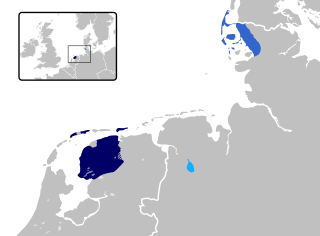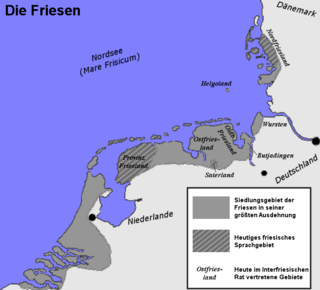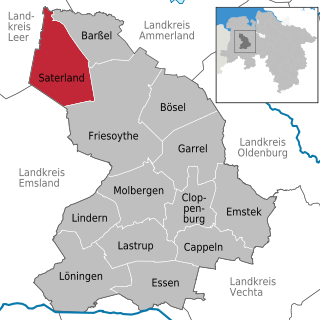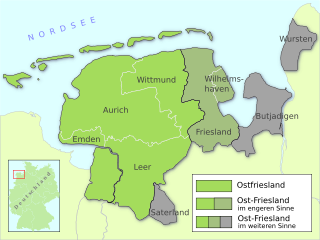See also
| | This disambiguation page lists articles associated with the title Saterland Frisian. If an internal link led you here, you may wish to change the link to point directly to the intended article. |
Saterland Frisian may refer to:
| | This disambiguation page lists articles associated with the title Saterland Frisian. If an internal link led you here, you may wish to change the link to point directly to the intended article. |

The Frisian languages are a closely related group of West Germanic languages, spoken by about 500,000 Frisian people, who live on the southern fringes of the North Sea in the Netherlands and Germany. The Frisian languages are the closest living language group to the Anglic languages; the two groups make up the Anglo-Frisian languages group and together with the Low German dialects these form the North Sea Germanic languages. However, modern English and Frisian are not mutually intelligible, nor are Frisian languages intelligible among themselves, due to independent linguistic innovations and foreign influences.
Frisian usually refers to:

The Frisians are a West Germanic ethnic group indigenous to the coastal parts of the Netherlands and northwestern Germany. They inhabit an area known as Frisia and are concentrated in the Dutch provinces of Friesland and Groningen and, in Germany, East Frisia and North Frisia. The Frisian languages are still spoken by more than 500,000 people; West Frisian is officially recognised in the Netherlands, and North Frisian and Saterland Frisian are recognised as regional languages in Germany.

Frisia is a historical coastal region along the southeastern corner of the North Sea in what today is mostly a large part of the Netherlands (Nederland), including modern Friesland, and smaller parts of northern Germany. Frisia is the traditional homeland of the Frisians, Germanic people who speak Frisian languages, which together with Anglic languages form the Anglo-Frisian language group.
East Frisian Low German or East Frisian Low Saxon is one of the Northern Low Saxon dialects, a West Low German dialect spoken in the East Frisian peninsula of northwestern Lower Saxony. It is used quite frequently in everyday speech there. About half of the East Frisian population in the coastal region uses the language. A number of individuals, despite not being active speakers of Low Saxon, are able to understand it to some extent. However, both active and passive language skills are in a state of decrease.
STQ is the call sign of a regional television station in Queensland, Australia.

Saterland Frisian, also known as Sater Frisian or Saterlandic (Seeltersk), is the last living dialect of the East Frisian language. It is closely related to the other Frisian languages: North Frisian, spoken in Germany as well, and West Frisian, spoken in the Dutch province of Friesland.

East Frisian is one of the Frisian languages. Its last surviving dialect is spoken in Saterland in Germany.

Saterland is a municipality in the district of Cloppenburg, in Lower Saxony, Germany. It is situated between the cities of Leer, Cloppenburg, and Oldenburg. It is home to the Saterland Frisian ethnic group who speak Frisian in addition to German.

The Anglo-Frisian languages are the West Germanic languages which include Anglic and Frisian varieties. The Northumbrian Language Society also considers Northumbrian an Anglic language.
East Frisian is an adjective referring to East Frisia, a region in Germany. It can refer specifically to:

Oldenburg Land is a region and regional association in the German state of Lower Saxony in the area of the former Grand Duchy of Oldenburg (1815–1918), the later Free State of Oldenburg (1918–1946) and administrative district of Oldenburg, without its exclaves, along the rivers Hunte and Hase. In the region between Waterkant, Dümmer and Damme Hills some of the population still speak Low German today and, in Saterland also Saterland Frisian. The region is rich in old Lower Saxon customs such as Schützenfests or Kohlfahrten. Typical country sports include Klootschießen and Boßeln.
Schulzentrum Saterland (SZS) is a general education day school in Lower Ramsloh, Saterland, in Lower Saxony, Germany, established in 1971, comprising both a primary and a secondary school. The school's name in their native Sater Frisian is "Grote Skoul fon't Seelterlound," the "Great School of Saterland." The school consists of both a high school and junior high school. The Laurentius-Siemer-Gymnasium was being constructed on the same site.

East Frisians are, in the wider sense, the inhabitants of East Frisia in the northwest of the German state of Lower Saxony. In the narrower sense the East Frisians are the eastern branch of the Frisians, a distinct Germanic ethnic group, and are one of the nationally recognized ethnic minorities in Germany, along with the Danes, Sorbs, Sinti and Romanies. They are closely related to the Saterland Frisians, who come from East Frisia and moved from the coastal region to the interior. The East Frisians are also related to the North Frisians and the Westlauwers Frisians.

North Frisians are the inhabitants of the district of Nordfriesland in the north German state of Schleswig-Holstein. Used in a narrower sense, the term also refers to an ethnic sub-group of the Frisians from the region of North Frisia, which lies primarily on the German North Sea coast, and on the island of Heligoland.
The West Frisians – or, more precisely, the Westlauwers Frisians – are those Frisian peoples in that part of Frisia administered by the Netherlands: the Province of Friesland, which is bounded in the west by the IJsselmeer and in the east by the River Lauwers.

The Saterland Frisians are one of the smallest language groups in Europe. They belong to the eastern branch of the Frisian people and are thus a recognised minority within Germany. They live in the Saterland, a community in the northern part of Cloppenburg district.

The East Frisian Peninsula refers to the North Sea coastal region of Germany between the bays of Dollart and Jade. It is distinct from East Frisia (Ostfriesland) which is a historic and cultural region that forms the western and central sections of the peninsula.
Wursten Frisian was a dialect of the East Frisian language that is thought to have been spoken until the early 18th century in the landscape of Wursten between Bremerhaven and Cuxhaven, Germany. Together with Harlingen Frisian and Wangerooge Frisian it belonged to the Weser Frisian group of dialects. The last East Frisian dialect still spoken today is Saterland Frisian, an Ems-group dialect.
Marron Curtis Fort was an American-born German linguist and professor who specialized in the study of Saterland Frisian language and Low German (plattdeutsch) spoken in northern Germany. Fort was a German citizen and lived in Leer. Fort's work in print and appearances in radio and television have contributed greatly to the preservation and furthering of the Saterland Frisian language and Low German language and culture in general.